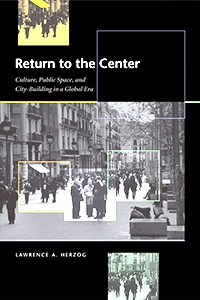 Return to the Center
Return to the Center
Culture, Public Space, and City-Building in a Global Era
2006
About
The redesign and revitalization of traditional urban centers is the cutting edge of contemporary urban planning, as evidenced by the intense public and professional attention to the rebuilding of city cores from Berlin to New York City’s “Ground Zero.” Spanish and Latin American cities have never received the recognition they deserve in the urban revitalization debate, yet they offer a very relevant model for this “return to the center.” These cultures have consistently embraced the notion of a city whose identity is grounded in its organic public spaces: plazas, promenades, commercial streets, and parks that invite pedestrian traffic and support a rich civic life. This groundbreaking book explores Spanish, Mexican, and Mexican-American border cities to learn what these urban areas can teach us about effectively using central public spaces to foster civic interaction, neighborhood identity, and a sense of place.
Herzog weaves the book around case studies of Madrid and Barcelona, Spain; Mexico City and Querétaro, Mexico; and the Tijuana-San Diego border metropolis. He examines how each of these urban areas was formed and grew through time, with attention to the design lessons of key public spaces. The book offers original and incisive discussions that challenge current urban thinking about politics and public space, globalization, and the future of privatized communities, from gated suburbs to cyberspace. Herzog argues that well-designed, human-scaled city centers are still vitally necessary for maintaining community and civic life. Applicable to urban renewal projects around the globe, Herzog’s book will be important reading for planners, architects, designers, and all citizens interested in creating more livable cities.
Excerpt
Had I but plenty of money,
money enough to spare
the house for me, no doubt,
were a house in the city square.
Ah, such a life, such a life,
as one leads at the window there.
Robert Browning, “Up at a Villa Down in the City,” Men and Women
Every new century begins with a kind of soul-searching. As North Americans, the entrée into the twenty-first century compels us to confront the critical place where most of us live—the metropolis. Several broad trends that ushered the close of the last century—globalization, privatization, and simulation—will continue to define the debates about urban form and function in the new millennium. The increasing globalization of urban development decisions raises concerns about the loss of local control over urban design. The continuing shift toward the privatization of urban space suggests that the already diminished importance of “public interest” in city planning may be further weakened. Meanwhile, the digital revolution has had a huge impact on the daily life of urban citizens, implying even greater distancing from the physical space of the city, from its design, and from previous historic eras that emphasized the creation of livable spaces for pedestrians. The postindustrial age has brought a new practice to the making of urban landscapes: the creation of artificial or simulated spaces—shopping malls, festival pavilions, video arcades—as the primary places where urban dwellers meet. The computer and its spin-off technologies, such as the Internet, pose radically different forms of urban interaction—cybercommunities and Internet cafés, for example.
